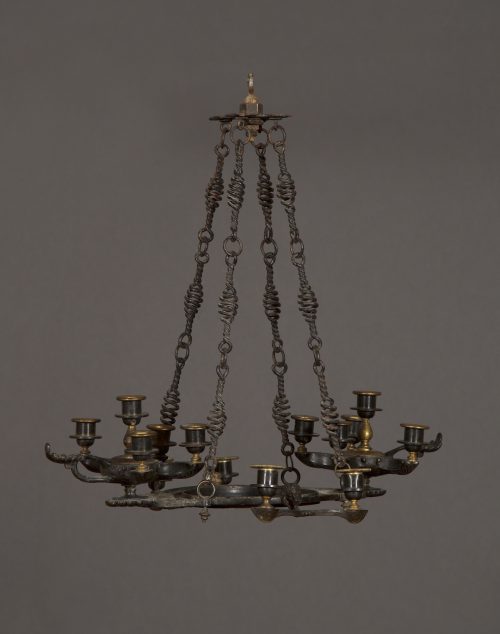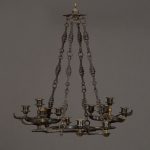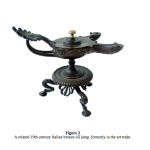9458 A PATINATED BRONZE FOURTEEN-LIGHT CHANDELIER IN THE ANCIENT ROMAN TASTE Italian. Mid Nineteenth Century. Measurements: Height: 22 5/8″ (57cm) Width: 22 6/8″ (58cm) Depth: 15″ (38cm).

Research
Of patinated bronze. The central ring supporting two ancient style oil lamps on opposing sides, each with five nozzles and anthemion handle, and two opposing lions head masks from which each issue a curved bar supporting a nozzle at both ends. The whole suspended from an quatrefoil cap by four patinated bronze chains of alternating ring and spiral shaped links.
The design of the present chandelier is inspired by ancient Greek and Roman oil lamps. Made of both bronze and pottery, the lamps could have a single, or multiple nozzles, and some also featured the distinctive anthemion on their handles like those reproduced on the present piece. An ancient example of a red slipped twin-nozzle pottery oil lamp from the 2nd century AD, formerly in a UK private collection is illustrated in figure 1, while a related 19th century Italian bronze oil lamp, formerly in the art trade, is seen in figure 2.
The chandelier also features lion masks issuing a curved bar with candle nozzles from their mouths. This form is reminiscent of the classical motif of a lion head clasping a ring in its mouth, often found serving as a door knocker. In the late eighteenth and early nineteenth centuries discoveries of ancient examples of lion masks on Roman sarcophagi caused designers to return to this classical prototype, which became very popular under the Empire Regime in France and during the Regency in Britain.
The explosion of interest in classical art in the 18th and 19th centuries, bolstered by privileged travelers making their Grand Tour, led to the sculptures, artwork and decorative art objects made in Italy for the foreign market, and abroad as part of authentic neoclassical decorative schemes.





Comments are closed.